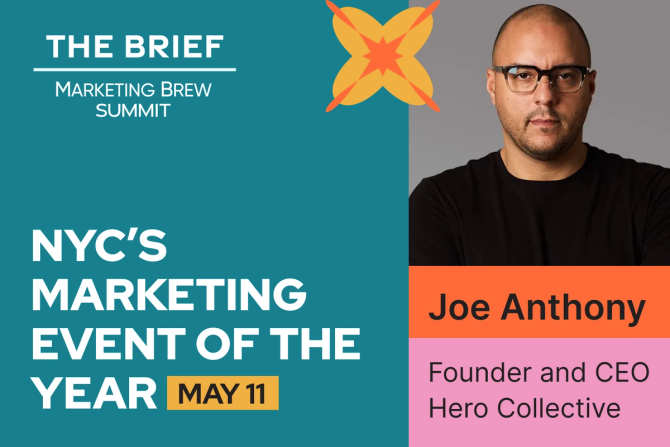Morning Brew - ☕ Stole the show
|
Older messages
☕ Signs of weakness
Thursday, March 16, 2023
Ryan Reynolds proved he's not just a movie star... March 16, 2023 View Online | Sign Up | Shop 10% Off Morning Brew TOGETHER WITH AT&T Good morning. As if we haven't already been through
☕ Go to bat
Tuesday, March 14, 2023
Investing in women's sports. March 14, 2023 Marketing Brew TOGETHER WITH Wistia It's Tuesday. It's also Pi Day, so brace yourselves for some of the cringiest brand promotions of the year.
☕ Search and state
Tuesday, March 14, 2023
The time to prepare for chatbot product search is now. March 14, 2023 Retail Brew TOGETHER WITH Bolt Happy Tuesday, everyone. It's Amazon Prime season for the beauty buffs out there; Ulta yesterday
☕ Light bulb leadership
Tuesday, March 14, 2023
Plus, old-school tricks in Slack and whose slogan is it anyway March 14, 2023 View Online | Sign Up | Shop 10% Off Raise Good morning. Last week, Patagonia announced it was purchasing Moonshot, a
☕ Everything changed
Tuesday, March 14, 2023
Did banks just get a bailout? March 14, 2023 View Online | Sign Up | Shop 10% Off Morning Brew TOGETHER WITH Cytonics Good morning. At an event outside Tokyo in 2006, Akira Haraguchi set an unofficial
You Might Also Like
How to Keep Providing Gender-Affirming Care Despite Anti-Trans Attacks
Sunday, March 9, 2025
Using lessons learned defending abortion, some providers are digging in to serve their trans patients despite legal attacks. Most Read Columbia Bent Over Backward to Appease Right-Wing, Pro-Israel
Guest Newsletter: Five Books
Sunday, March 9, 2025
Five Books features in-depth author interviews recommending five books on a theme Guest Newsletter: Five Books By Sylvia Bishop • 9 Mar 2025 View in browser View in browser Five Books features in-depth
GeekWire's Most-Read Stories of the Week
Sunday, March 9, 2025
Catch up on the top tech stories from this past week. Here are the headlines that people have been reading on GeekWire. ADVERTISEMENT GeekWire SPONSOR MESSAGE: Revisit defining moments, explore new
10 Things That Delighted Us Last Week: From Seafoam-Green Tights to June Squibb’s Laundry Basket
Sunday, March 9, 2025
Plus: Half off CosRx's Snail Mucin Essence (today only!) The Strategist Logo Every product is independently selected by editors. If you buy something through our links, New York may earn an
🥣 Cereal Of The Damned 😈
Sunday, March 9, 2025
Wall Street corrupts an affordable housing program, hopeful parents lose embryos, dangers lurk in your pantry, and more from The Lever this week. 🥣 Cereal Of The Damned 😈 By The Lever • 9 Mar 2025 View
The Sunday — March 9
Sunday, March 9, 2025
This is the Tangle Sunday Edition, a brief roundup of our independent politics coverage plus some extra features for your Sunday morning reading. What the right is doodling. Steve Kelley | Creators
☕ Chance of clouds
Sunday, March 9, 2025
What is the future of weather forecasting? March 09, 2025 View Online | Sign Up | Shop Morning Brew Presented By Fatty15 Takashi Aoyama/Getty Images BROWSING Classifieds banner image The wackiest
Federal Leakers, Egg Investigations, and the Toughest Tongue Twister
Sunday, March 9, 2025
Homeland Security Secretary Kristi Noem said Friday that DHS has identified two “criminal leakers” within its ranks and will refer them to the Department of Justice for felony prosecutions. ͏ ͏ ͏
Strategic Bitcoin Reserve And Digital Asset Stockpile | White House Crypto Summit
Saturday, March 8, 2025
Trump's new executive order mandates a comprehensive accounting of federal digital asset holdings. Forbes START INVESTING • Newsletters • MyForbes Presented by Nina Bambysheva Staff Writer, Forbes
Researchers rally for science in Seattle | Rad Power Bikes CEO departs
Saturday, March 8, 2025
What Alexa+ means for Amazon and its users ADVERTISEMENT GeekWire SPONSOR MESSAGE: Revisit defining moments, explore new challenges, and get a glimpse into what lies ahead for one of the world's









